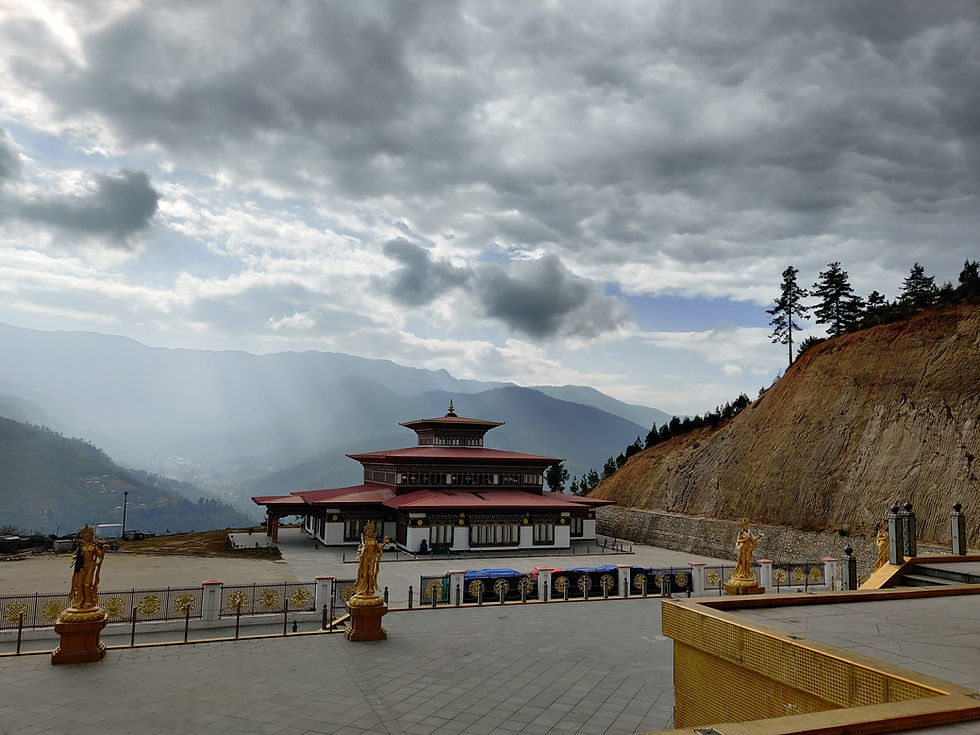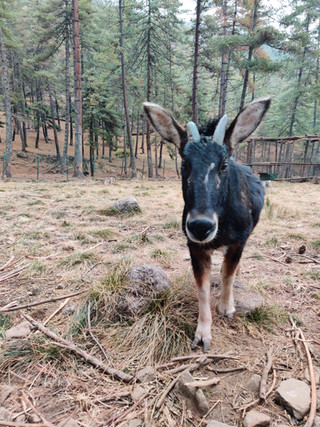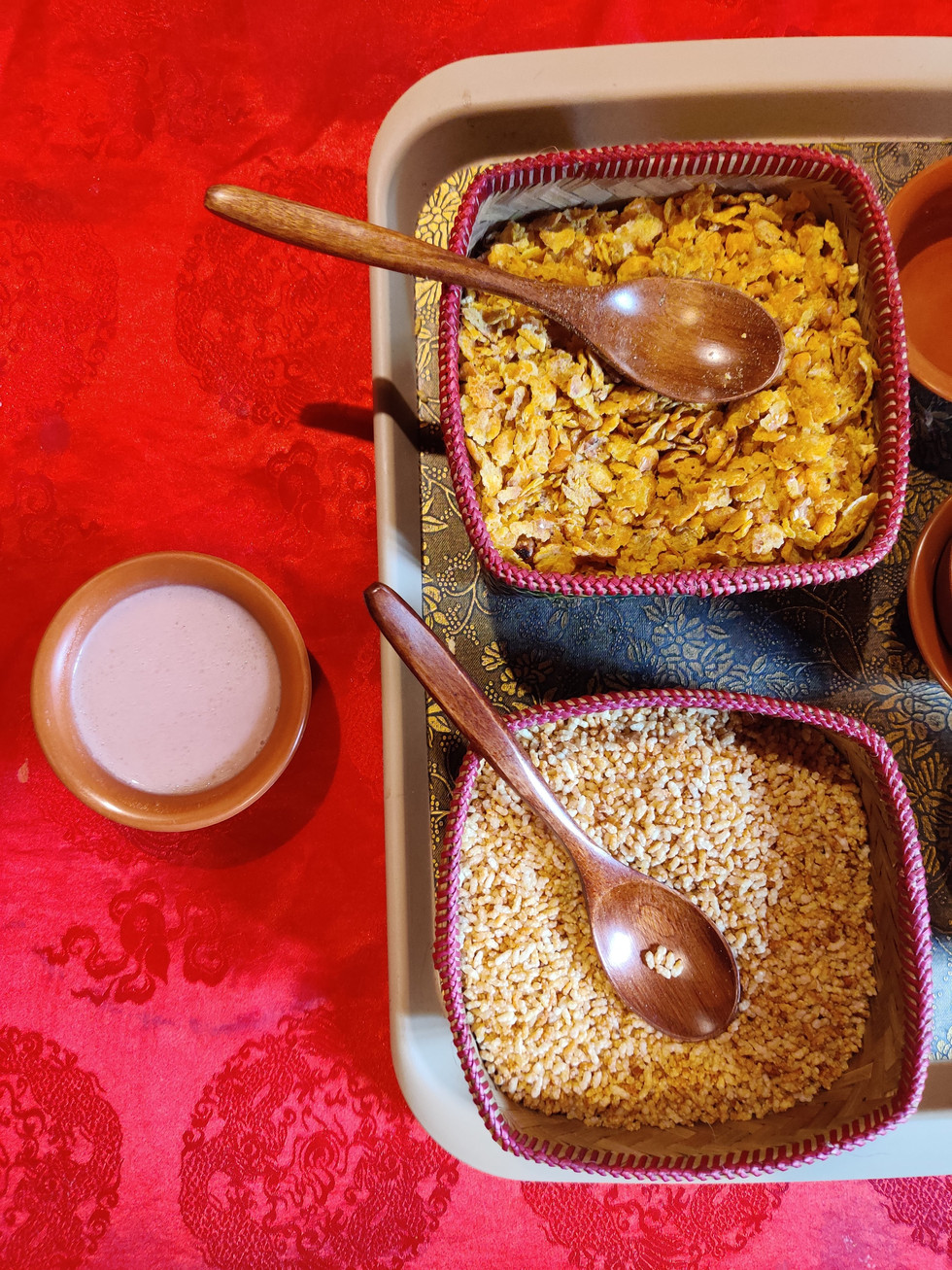The Land of the Thunder Dragon: Bhutan, the Happiest Nation
- Sai Venkatesh Vemuri
- Jun 9, 2024
- 10 min read
Updated: Nov 12, 2024
In Bhutan, happiness permeates every corner of this mountain kingdom, enveloping visitors in an aura of peace, genuine smiles, and breathtaking beauty. It's almost guaranteed that you'll carry a piece of Bhutan's charm back home with you after your visit.

Table of Contents
Note: I embarked on this adventure with On His Own Trip (OHOT), an amazing team that organizes group trips to exciting destinations both within and beyond India. Be sure to check them out! Just a heads-up, I'm not getting any monetary benefit or perks for mentioning them—I just genuinely love their trips.
Bhutan, cradled in the Himalayas between India and Tibet, is a landlocked haven renowned for its unique approach to measuring success through Gross National Happiness (GNH) rather than Gross Domestic Product (GDP). The moment I learned about this philosophy, I knew Bhutan had to be my first destination outside of India. While that didn't happen, I eventually found myself in this earthly paradise.
How to reach?
Bhutan can be accessed by air or by road, with flights being limited and often pricey. Interestingly, pilots undergo rigorous training to navigate the challenging terrain of Paro airport, surrounded by majestic mountains. However, the road journey, particularly from India via Jaigaon-Phuentsholing border crossing, is favored by many, offering a scenic and adventurous route.
Bhutan, known for its commitment to environmental sustainability, relies heavily on tourism. In a bid to promote responsible travel practices, they impose a Sustainable Development Fee (SDF) of BTN 1200 per night for Indian nationals and USD 200 per night for other nationalities. It's worth noting that the Bhutanese Ngultrum (BTN) is pegged to the Indian Rupee (INR) at parity. Indian nationals are required to present either a Passport or Voter ID card, whereas other nationals must have a valid passport to obtain the visa.

Phuentsholing
Immigration procedures are typically swift, usually lasting less than an hour. Upon crossing into Phuentsholing, the Bhutanese border town, one is immediately greeted by a striking architectural contrast, characterized by a myriad of Buddhist influences. The markets here are buzzing with activity – perfect for picking up souvenirs and, of course, stocking up on Bhutanese grain whiskey and Zumzin peach wine. They've been our go-to drinks for entire trip!

Thimphu
Thimphu, the vibrant capital of Bhutan, lies just a scenic 4-hour drive from Phuentsholing. Nestled in a picturesque valley along the Thimphu Chu River, Thimphu offers stunning views of this winding waterway from virtually every corner of the city. As the political heart of Bhutan, Thimphu is home to the National Assembly and the King's Palace. But that's just the beginning of what this enchanting city has to offer. From bustling markets and lively festivals to serene monasteries and panoramic hiking trails, Thimphu beckons travelers with its unique blend of tradition and modernity.
Buddha Dordenma
The Buddha Dordenma Statue stands as Bhutan's largest monument, towering at an impressive 169 feet and ranking among the tallest in the world. Crafted from bronze and adorned with a gilded gold finish, this magnificent statue rests atop a grand structure that also houses a serene meditation hall. Within this hall lie an astounding 125,000 Buddha idols, some of which are presented by nations from around the globe.

The statue depicts Shakyamuni Buddha in a seated posture. The construction of this monument fulfilled two ancient prophecies dating back to the 8th and 12th centuries, which foretold the construction of a monumental Buddha statue in the region, destined to bestow peace and happiness upon the world.

Resting atop a mountain, the statue offers a breathtaking vantage point, allowing visitors to gaze upon the entirety of the picturesque city of Thimphu.

Royal Takin Preserve
The Royal Takin Preserve is a sanctuary dedicated to the preservation and protection of the Takin, the national animal of Bhutan. The sanctuary also serves as an educational center, raising awareness about the importance of forest and wildlife conservation. The area is populated with towering trees and offers hiking trails, promising an enjoyable outdoor experience.
According to Bhutanese folklore, the Takin, Bhutan's national animal, has a curious origin story. Legend has it that a revered saint merged the body of a cow with the head of a goat, creating the unique creature we now recognize as the Takin. This fascinating tale adds to the mystique of the creature. The preserve also contains deer and other animals.
The journey to the Royal Takin Preserve treats you to some of the most captivating views of Thimphu city.

Simply Bhutan - Cultural Museum
Simple Bhutan offers a vibrant window into Bhutanese culture, inviting you to experience the traditional cuisine, witness captivating performances, and immerse yourself in various other activities. The traditional folk dance marks the beginning of an immersive cultural experience.

Next up is a delightful spread of Bhutanese cuisine, featuring specialties like Suja, a traditional Butter Tea served with roasted rice and beaten corn, and Emadatshi, the national dish consisting of cheese and vegetables - a favorite that we couldn't resist ordering for the remainder of our trip.
We even joined in and also taught them some Indian folk dance ;)
You can explore the intricate architecture and layout of traditional Bhutanese homes, observe the arrangement of kitchens, participate in archery, and admire traditional masks and artifacts on display. Don't miss the opportunity to taste Ara, the home brewed wine. Additionally, take a moment to admire the serene statue of Buddha and toss a coin into the wishing pond, making heartfelt wishes.
In a tradition akin to the worship of Shiva in the form of the Lingam in India, Bhutanese culture reveres the Phallus as a symbol of good luck and protection against evil spirits. Paintings and statues depicting the Phallus are seen throughout Bhutan, underscoring its significance. Here, a small shrine dedicated to Lama Drukpa Kuenley and the Phallus stands as a testament to this unique aspect of Bhutanese culture.

Tashichho Dzong
Dzongs, the fortified structures scattered throughout Bhutan, serve as vital centers of administration and spirituality. These architectural marvels boast administrative wings housing government offices alongside religious quarters featuring ornate temples and monk residences. In each major district, a Dzong stands proudly as a symbol of local identity and tradition, hosting vibrant annual festivals like Tshechu that celebrate Bhutanese culture with colorful rituals and dances.
Located in the capital city of Thimphu, one can witness the intricate beauty of Tashichho Dzong's architecture and the serene ambiance of its courtyards while exploring the vibrant cultural tapestry within its walls. I would recommend people to visit Dzongs closer to the sunset to view it in the daylight and illuminated at night.
Thimphu's nightlife is pretty lively, with lots of bars that have live music where you can chill out with some local or regular drinks. Plus, alcohol in Bhutan is super cheap compared to India.
Don’t forget to join in on the cafe and bar hopping fun!
From the outset, the profound influence of monarchy is evident in Bhutan. The portraits of the royal family is visible throughout the country. They continue to command genuine respect and admiration from the people.
The reigning monarch, King Jigme Khesar Namgyel Wangchuck, and Queen Jetsun Pema exemplify remarkable leadership and dedication to numerous charitable endeavors, endearing them to everyone. Moreover, it's hard not to be awed by the Queen's beauty, undoubtedly making her one of the most captivating royals.

Dochula Pass
Dochula Pass is a scenic mountain pass located on the road from Thimphu to Punakha. Situated at an elevation of around 3,100 meters (10,200 feet), it offers breathtaking panoramic views of the surrounding Himalayan mountains. We were lucky enough to witness snowfall here.
The pass is adorned with 108 chortens, or stupas, known as "Druk Wangyal Chortens," built by the Queen Mother to honor Bhutanese soldiers who lost their lives in the line of duty. One can take leisurely walks around the area and simply soak in the tranquility of the mountains...

or click some crazy photographs.

Punakha
Located approximately 2 hours from Thimphu, Punakha served as the former capital of Bhutan. It boasts several significant historical and religious landmarks, making it an important destination in the nation.

Unlike the bustling urban centers of Thimphu or Paro, Punakha retains a more laid-back atmosphere, offering visitors the opportunity to wander its streets and engage with the local community.

Pungtang Dechen Phodrang Dzong
The most iconic landmark in Punakha is the Punakha Dzong, also known as the "Pungthang Dewachen Phodrang" or "Palace of Great Happiness." Built at the confluence of the Pho Chhu (father) and Mo Chhu (mother) rivers. It remains an active administrative and religious center, hosting various ceremonies and festivals throughout the year.

This majestic fortress-monastery is renowned for its stunning architecture, intricate woodwork, and vibrant paintings. Adorning the monastery's interior are grand wall paintings, each intricately depicting stories from the life and teachings of Buddha, offering visitors a glimpse into the rich tapestry of Bhutanese spirituality.
The Dzong has weathered numerous challenges, including flash floods, earthquakes, and fires, yet it has been meticulously restored each time. As dusk falls, the Dzong is illuminated by warm lights, casting a spellbinding glow that adds to its enchanting allure. For me, this Dzong stands out as a personal favorite, a testament to resilience and timeless beauty.

Suspension Bridge
Spanning the pristine waters of the Po Chhu River in Punakha, Bhutan, the Punakha Suspension Bridge is a popular tourist attraction. As Bhutan's longest suspension bridge, stretching an impressive 160 meters, it offers travelers an unparalleled opportunity to immerse themselves in the breathtaking scenery of the region.

A brief trek leads to the bridge. Despite its suspension, the bridge has a stable footing, ensuring a leisurely walk for all who venture across. The unparalleled view of the river below, admired from the bridge's central vantage point, that truly steals the show, leaving visitors in awe of the natural splendor that surrounds them.

Paro
Nestled amidst the scenic landscapes, Paro stands as a captivating blend of cultural splendor and natural wonders. Situated approximately three hours away from Punakha, the town serves as a gateway to Bhutan's rich heritage and is renowned for its breathtaking beauty. It consists of Bhutan's sole international airport.
Flowing gracefully through the town is the Paro Chu River, its gentle waters weaving a picturesque tapestry against the backdrop of verdant hills and quaint architecture. Mesmerized by the serene ambiance, we couldn't resist the urge to pause our journey and immerse ourselves in the tranquil beauty of the riverbanks.

and we of course had to dip our feet in ice-cold waters :)

Neyphug Heritage
During our journey, we paused for lunch at Neyphug Heritage, a charming establishment boasting rustic aesthetics. Once in ruins, the property has been lovingly redeveloped into a delightful café, offering not only delicious cuisine but also breathtaking views of the surrounding landscapes. The souvenir store in the premises contains an array of delightful products that are certainly worth exploring.

And they also let (and tolerated?) us sing.

Paro Taktsang aka Tiger's Nest
Paro Taktsang, also known as the Tiger's Nest Monastery, stands as an iconic symbol of Bhutan and is a must-visit destination for travelers. The trek to this monastery is a memorable experience, requiring moderate fitness to complete the ascent in about two hours.

Along the way, hikers traverse through enchanting pine forests, catching glimpses of the monastery and the valley below. The trail is adorned with colorful prayer flags, serene water streams, and occasional waterfalls, offering a tranquil journey amidst nature's beauty.
The monastery is on the edge of a cliff at an altitude of 3,120 meters (10,240 feet), the complex comprises several temples and sacred chambers interconnected by staircases and corridors. Photography is prohibited inside the complex.
Legend has it that Guru Padmasambhava, known as the Second Buddha, meditated in a cave here in the 8th century after arriving on the back of a tigress, thus giving the monastery its name. The site holds significant religious and cultural importance for Bhutanese people and Buddhists worldwide.

The trek to Paro Taktsang, aka Tiger's Nest, will always remain one of the most memorable experiences - the trail, views, people, snowfall, and tranquility.
The markets in Paro offer a variety of local goods, handicrafts, and souvenirs, providing visitors with a glimpse into Bhutanese culture and craftsmanship. Strolling through these markets, you'll find a variety of items such as handmade textiles, intricate woodcarvings, paintings and jewellery. Don't miss out on the fantastic dining options available in the area.
Rinpung Dzong
Rinpung Dzong, also known as Paro Dzong, is a majestic fortress-monastery situated in the Paro Valley. Constructed in the 17th century, Rinpung Dzong serves as both a fortress and a religious center.

The dzong is an architectural marvel, characterized by its intricate woodwork, whitewashed walls, and traditional Bhutanese design. Visitors can explore its courtyards, temples, and halls, adorned with colorful murals, Buddhist scriptures, and sacred relics.
It stands on a hillside overlooking the Paro Chu river and offers stunning panoramic views of the surrounding mountains and the town of Paro.
The Gho and Kira are integral parts of Bhutanese culture, serving as the national dress for men and women. Seeing locals dressed in these traditional garments is a common sight, given their widespread use in Bhutanese society. Eager to immerse ourselves in the local customs, we decided to don the Gho and Kira during our visit. While it took some effort to get the attire just right, I found the attire to be remarkably comfortable.

And that concludes our trip, saying goodbye is never easy, is it?

Bhutan was pure magic that filled me with genuine happiness. This is a perfect place to look around and look within, and at the end of the trip you will (and must) take a bit of Bhutan back with you.
And that wraps up this journey! Be sure to explore more stories on this blog. I'd love to hear from you, so feel free to connect through the contact section.
Essential Information
Who should visit?
Nature Lover
Culinary Enthusiast
Spiritual Seeker
Architecture Buff
Luxury Traveller
When to visit?
Anytime of the year
Experience the festival vibes by planning during Tshechu in any district
If you're not a fan of the cold, steer clear of winters (Dec-Feb)
Where to Stay?
No recommendations
What to do?
Buddha Dordenma
Tashichho Dzong
Dochula Pass
Pungtang Dechen Phodrang Dzong
Punakha Suspension Bridge
Paro Taktsang aka Tiger's Nest
Rinpung Dzong
How to travel?
By air - flight to Paro International Airport
By road - India-Bhutan Border via Jaigaon-Phuentsholing crossing
Use public transport to reach major cities like Thimphu, Punakha, and Paro
Hire a taxi for local travel within the cities
Recommended Trip Duration
7 Days / 6 Nights
Estimated Trip Budget
~INR 55,000 per Person*
* 1. Excluding transportation costs via flight or train to Bagdogra / Siliguri.
2. INR 40,000 was charged by OHOT for this trip that included all transportation, accommodation and guided tour in Bhutan.
_PNG.png)



































































Comments